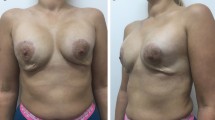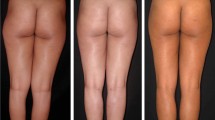Abstract
Background
Subcutaneous cardiac devices can sometimes undergo exposure, and often, the removal and contralateral repositioning of a new device is necessary. Pressure sores of the device cause a gradual thinning of the cutaneous and subcutaneous layers resulting in implant exposure. Our department has developed a closed collaboration with the Department of Cardiology in order to prevent the exposure of subcutaneous devices and to avoid the more risky and invasive surgery necessary for implant removal and reposition.
Methods
Thirty selected cardiopathic patients presenting pressure sores of the device, without exposure, were selected for lipofilling. The selection of patients is a key moment to ensure the success of the procedure. The surgery was performed under local anaesthetic without epinephrine.
Results
There was an improvement of local conditions, and none of the patients, after a year, were subjected to a removal operation of the implant. No cases of infection were observed.
Conclusions
Adipose tissue graft improved cutaneous trophism and increased the thickness of the subcutaneous tissue, reducing the risk of implant exposure.
Level of Evidence: Level IV, risk/prognostic study.




Similar content being viewed by others
References
Mond HG, Proclemer A (2011) The 11th world survey of cardiac pacing and implantable cardioverterdefibrillators: calendar year 2009—a World Society of Arrhythmia's project. Pacing Clin Electrophysiol 34:1013–1027
Voigt A, Shalaby A, Saba S (2010) Continued rise in rates of cardiovascular implantable electronic device infections in the United States: temporal trends and causative insights. Pacing Clin Electrophysiol 33:414–419
Johansen JB, Jørgensen OD, Møller M, Arnsbo P, Mortensen PT, Nielsen JC (2011) Infection after pacemaker implantation: infection rates and risk factors associated with infection in a population based cohort study of 46299 consecutive patients. Eur Heart J 32:991–998
Klug D, Lacroix D, Savoye C, Goullard L, Grandmougin D, Hennequin JL, Kacet S, Lekieffre J (1997) Systemic infection related to endocarditis on pacemaker leads: clinical presentation and management. Circulation 95:2098–2107
Dy Chua J, Wilkoff BL, Lee I, Longworth D, Gordon SM (2000) Diagnosis and management of infection involving implantable electrophysiologic cardiac devices. Ann Intern Med 133:604–608
Klug D, Wallet F, Lacroix D, Marquie C, Kouakam C, Kacet S, Courcol R (2004) Local symptoms at the site of pacemaker implantation indicate latent systemic infection. Heart 90:882–886
Wilkoff BL, Love CJ, Byrd CL, Bongiorni MG, Carrillo RG, Crossley GH Jr, Epstein LM, Friedman RA, Kennergren CE, Mitkowski P, Schaerf RH, Wazni OM (2009) Transvenous lead extraction: Heart Rhythm Society expert consensus on facilities, training, indications, and patient management: this document was endorsed by the American Heart Association (AHA). Heart Rhythm 6(7):1085–1104
Rigotti G, Marchi A, Galiè M et al (2007) Clinical treatment of radiotherapy tissue damage by lipoaspirate transplant: a healing process mediated by adipose-derived adult stem cells. Plast Reconstr Surg 119(5):1409–1422, discussion 1423-4
Rigotti G, Marchi A, Micciolo R, Baroni G. Autologous fat grafting in breast cancer patients. Breast. 2012 Jun 29. [Epub ahead of print]
Klinger M, Marazzi M, Vigo D, Torre M (2008) Fat injection for cases of severe burn outcomes: a new perspective of scar remodeling and reduction. Aesthetic Plast Surg 32(3):465–469
Brongo S, Nicoletti GF, La Padula S, Mele CM, D’Andra F (2012) Use of lipofilling for the treatment of severe burn outcomes. Plast Reconstr Surg 130(2):374e–376e
Bui P (2008) Lipofilling. Ann Dermatol Venereol 135(1 Pt 2):1S50–1S58
Rigotti G, Marchi A, Sbarbati A (2009) Adipose-derived mesenchymal stem cells: past, present, and future. Aesthetic Plast Surg 33(3):271–273, Epub 2009 Apr 21
Kolker AR, Redstone JS, Tutela JP (2007) Salvage of exposed implantable cardiac electrical devices and lead systems with pocket change and local flap coverage. Ann Plast Surg 59:26–29, discussion 30
Turkisher V, Priel I, Dan M (1997) Successful management of an infected implantable cardioverter defibrillator with oral antibiotics and without removal of the device. PACE 20:268–2270
Yamada M, Takeuchi S, Shiojiri Y, Maruta K, Oki A, Iyano K, Takaba T (2002) Surgical lead preserving procedures for pacemaker pocket infections. Ann Thorac Surg 74:1494–1499
Molina JE (1997) Undertreatment and overtreatment of patients with infected antiarrhythmic implantable devices. Ann Thorac Surg 63:504–509
Vogt PR, Sagdic K, Lachat M, Candinas R, von Segesser LK, Turina MI (1996) Surgical management of infected permanent transvenous pacemaker systems: ten year experience. J Card Surg 11:180–186
Tsai V, Chen H, Hsia H, Zei P, Wang P, Al-Ahmad A (2007) Cardiac device infections complicated by erosion. J Interv Card Electrophysiol 19(2):133–137
Parry G, Goudevenos J, Jameson S, Adams PC, Gold RG (1991) Complications associated with retained pacemaker leads. Pacing Clin Electrophysiol 14:1251–1257
Siu CW, Cheng LC, Woo PC, Lau CP, Tse HF (2007) A patient with relapsing pacemaker infection due to “gram-positive bacilli”. Int J Cardiol 114:E40–E41
Nandyala R, Parsonnet V (2006) One stage side-to-side replacement of infected pulse generators and leads. Pacing Clin Electrophysiol 29:393–396
Dy Chua J, Abdul-Karim A, Mawhorter S, Procop G, Tchou P, Niebauer M, Saliba W, Schweikert R, Wilkoff B (2006) The role of swab and tissue culture in the diagnosis of implantable cardiac device infection. Pacing Clin Electrophysiol 28:1276–1281
Klug D, Wallet F, Kacet S, Courcol RJ (2005) Detailed bacteriologic tests to identify the origin of transvenous pacing system infections indicate a high prevalence of multiple organisms. Am Heart J 149:322–328
Golzio PG, Vinci M, Anselmino M, Comoglio C, Rinaldi M, Trevi GP, Bongiorni MG (2009) Accuracy of swabs, tissue specimens, and lead samples in diagnosis of cardiac rhythm management device infections. Pacing Clin Electrophysiol 32(Suppl 1):S76–S80
Condé-Green A, de Amorim NF, Pitanguy I (2010) Influence of decantation, washing and centrifugation on adipocyte and mesenchymal stem cell content of aspirated adipose tissue: a comparative study. J Plast Reconstr Aesthet Surg 63(8):1375–1381, Epub 2009 Aug 12
Conflict of interest
None
Patient consent
Patients provided written consent prior to their inclusion in the study
Ethical standards
The study was approved by the ethics committee of our institution and was performed in accordance with the ethical standards laid down in the 1964 Declaration of Helsinki and its later amendments. Details that might disclose the identity of the patients under study were omitted.
Author information
Authors and Affiliations
Corresponding author
Rights and permissions
About this article
Cite this article
Bocchiotti, M.A., Kefalas, N., Bellezza, E. et al. Fat grafting used for the prevention of cardiac implantable electronic devices (CIED) exposure. Preliminary report of a clinical study. Eur J Plast Surg 37, 673–678 (2014). https://doi.org/10.1007/s00238-014-1003-z
Received:
Accepted:
Published:
Issue Date:
DOI: https://doi.org/10.1007/s00238-014-1003-z




